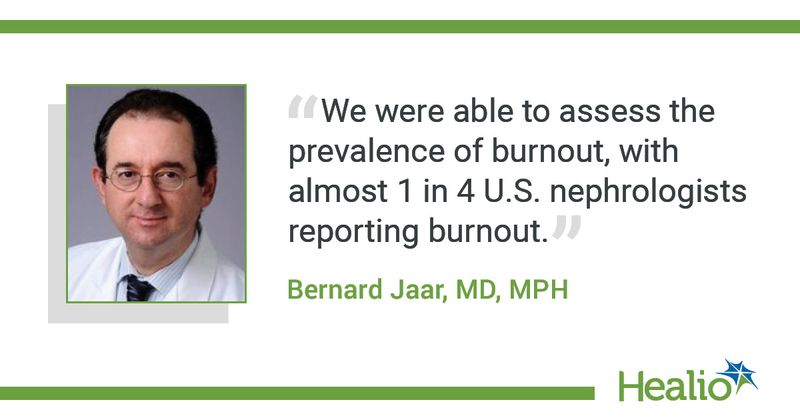Caring for fewer patients, practicing in academic settings reduces burnout
In a survey of nephrologists, caring for no more than 25 patients, practicing in academic settings and tending to non-patient care responsibilities correlated with nearly 70% lower odds of burnout.
Further, nephrologists reported numbers of hours worked and electronic health record requirements as primary causes of burnout.


“Recent studies have reported that burnout is more prevalent among health care workers than the general population; however, little is known about this issue among nephrologists,” Bernard G. Jaar, MD, MPH, a staff nephrologist at the Nephrology Center of Maryland and Johns Hopkins University, told Healio. “We thought it was important to address burnout among practicing nephrologists and conducted a national survey.”
In a cross-sectional study, researchers evaluated nephrologists to determine the frequency and causes of burnout. Responses and nephrologist characteristics were collected using the AMA Physicians Masterfile, National Kidney Foundation listserv, email and social media between April and August 2019. One or more responses from an individual nephrologist as reporting validated measures of emotional exhaustion and depersonalization “once a week” or more was defined as burnout.
Researchers tabulated respondents’ characteristics, then compared answers using chi-square tests. Using multivariable logistic regression odds ratios, researchers identified risk factors for burnout.
Among 457 respondents (49.2% were 40-59 years old; 64.8% were men; 62.6% were in academic practice), 106 reported experiencing burnout. Common causes of burnout were numbers of hours worked and EHR requirements.
However, surveys revealed that caring for no more than 25 patients vs. 26 to 75 patients per week, practicing in academic vs. non-academic settings and spending time with other responsibilities vs. patient care independently correlated with about 70% lower odds of burnout.
“We were able to assess the prevalence of burnout, with almost one in four U.S. nephrologists reporting burnout. Further, some common factors driving burnout in the health care workforce were identified such as number of hours worked per week and electronic health records requirements,” Jaar told Healio. “It is also important to note that this high prevalence was observed before the COVID-19 pandemic, and we believe that with the pandemic, burnout is now likely worse.”

